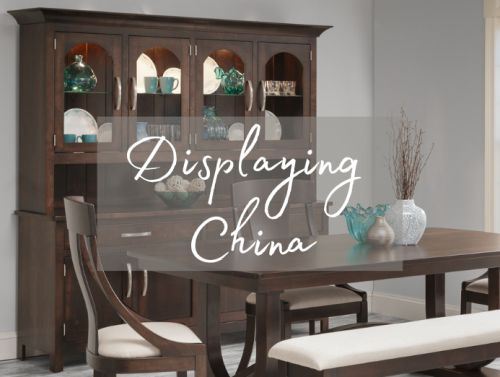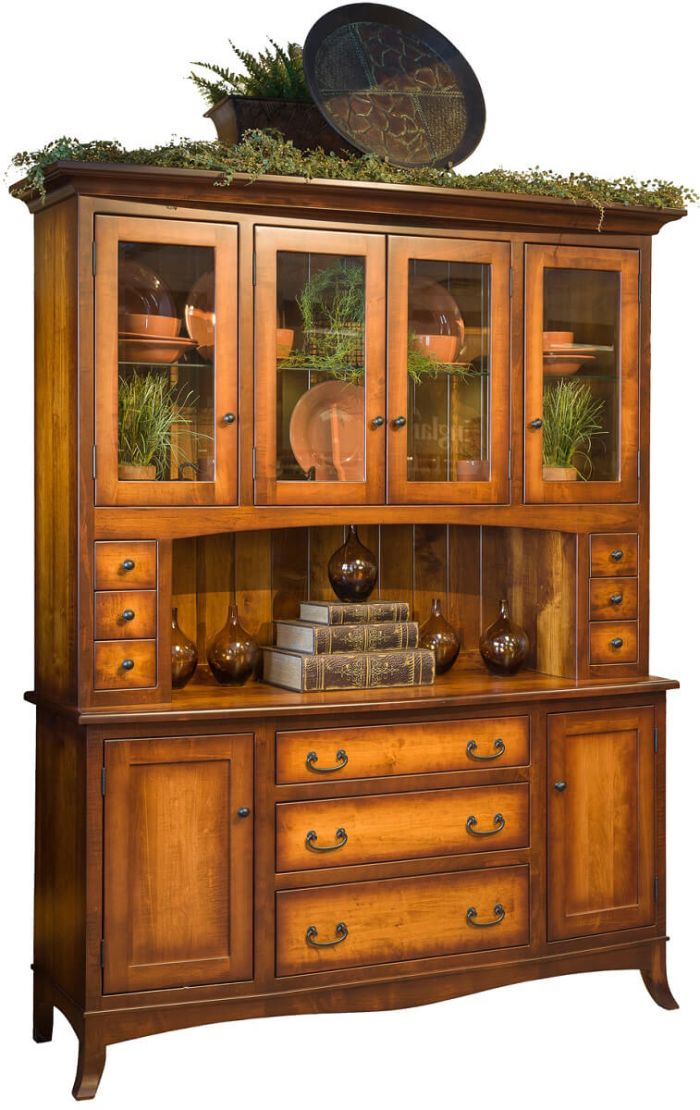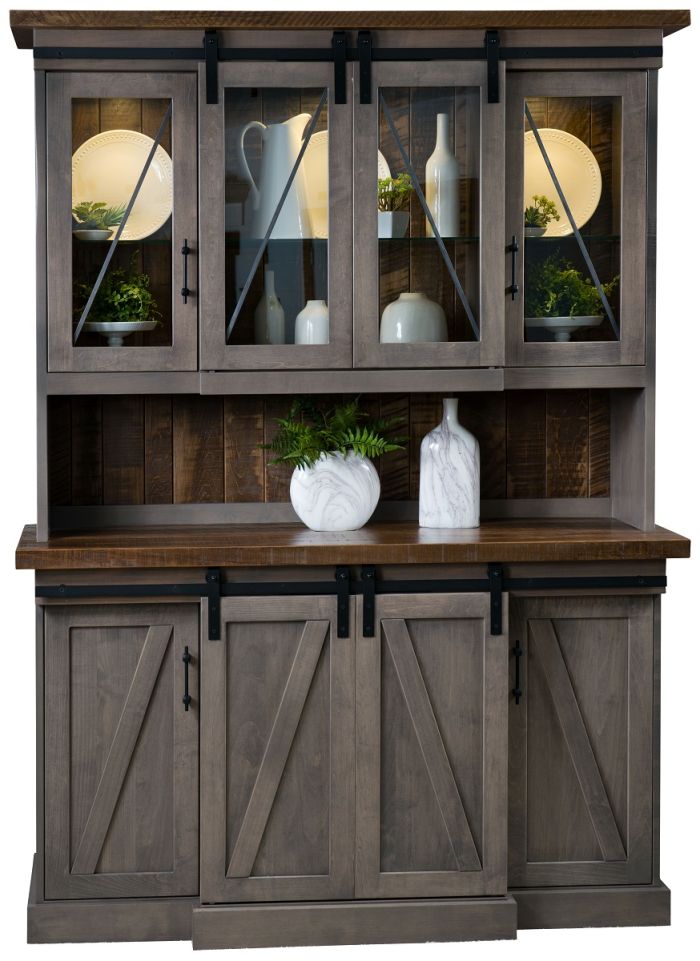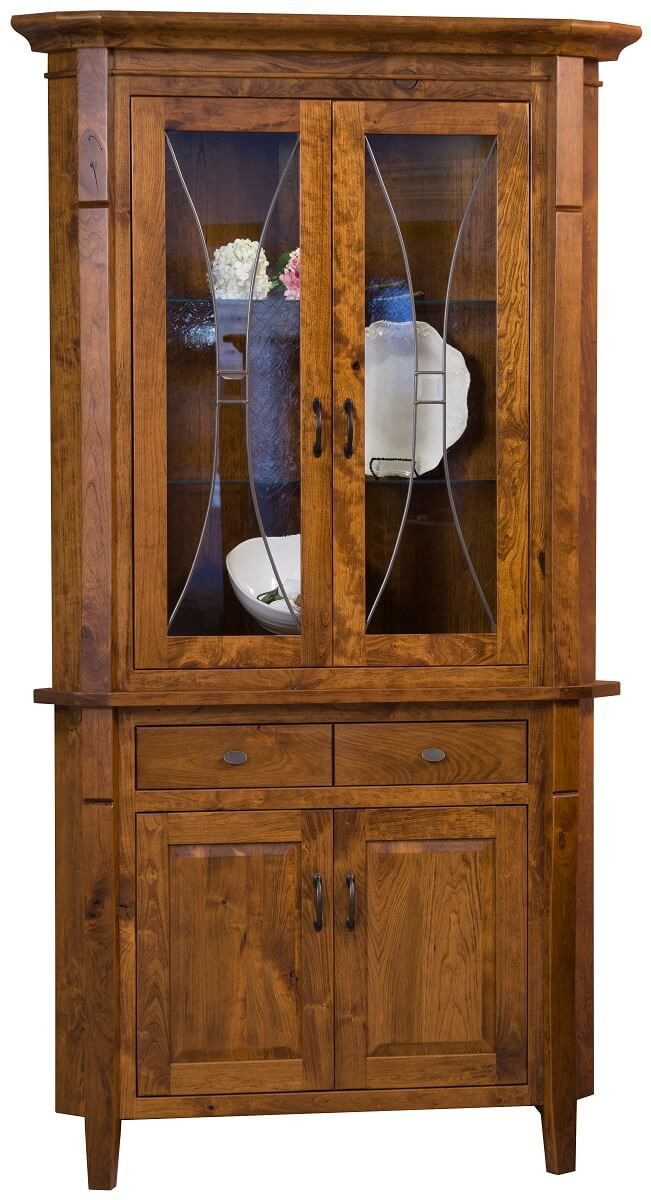How to Display China Inside Your Cabinet - Ideas and Tips
By Bailiegh Basham · August 10, 2022
You have the china and you have the cabinet—now, all you have to do is put one inside the other. However, it’s natural that questions should arise about how to display your china within the cabinet. Do it incorrectly, and the resulting visual detracts from your dining room.
Follow these tips and experiment with different arrangements, and you can find a china display configuration within your cabinet that enhances the overall space.
Balance the Two China Cabinet Functions: Display & Storage
Most pieces of furniture serve one purpose; a chair is meant for sitting, a trunk is meant for storage, and a desk is meant for working. China cabinets break this trend, serving dual roles by fulfilling both display and storage functions. To take advantage of both:
- Find china display cabinets with both opaque and glass doors. A common design choice for Amish-made china cabinets is solid wood doors in the base, ideal for the less attractive, everyday use dishware. This will be where the majority of your storage lies, as you don’t have to worry about visually spacing goods. The upper shelving of the china cabinet should have glass doors or no doors, enabling you to display your finer china and wares. Here, significantly more consideration should go into what and how you exhibit.
- With upper shelves, mix decorative decisions with practical ones. Consider displaying a beloved china plate upright (supported by a stand) while having others stacked behind or, if shorter, in front. Another idea is to alternate behind dishware and artistic pieces like pitchers or cut crystal
Add Visual Intrigue to the Cabinet Without Creating Clutter
Ideas for Limiting Visual Chaos Within Your Display Cabinet
While displaying a variety of different pieces can infuse the china cabinet with personality, you run the risk of creating a visual mess. Therefore, make sure to achieve symmetry within your china cabinet. This doesn’t mean the left and right sides must mirror one another, but there should be balance in color, volume, and textiles.
Another good idea? Limit the main colors of your wares to no more than two (though you may be able to get away with three). This makes it easier to have a uniting theme throughout your china cabinet’s contents. Keep in mind, that nontraditional hues like those of crystal, wood, and plants should count towards your display cabinet’s capped color scheme.
Have consistent margins between each stack or item you display within your china cabinet. Ideally, spacing between each grouping would be well-defined to make positioning feel purposeful rather than one messy blur. However, regardless of whether this can or cannot be achieved, it’s important to remain consistent when creating margins within your china cabinet.
 Ideas for Displaying China With Visual Intrigue Inside Your Cabinet
Ideas for Displaying China With Visual Intrigue Inside Your Cabinet
We’ve given you tips for nurturing a tidy appearance, and now we want to give you ideas to spur your creativity! Make your china cabinet’s contents draw the eye with the following:
- Mix textiles, patterns, and colors (in most cases, no more than three) - This can be achieved through a bold china set or mixing various materials, such as porcelain with crystal.
- Play around with heights and shapes - Stacking items in front of one another adds visual depth. Take advantage of this by placing shorter goods in front of taller goods (such as a cup in front of an upright plate).
- Add non-dishware elements - Fitting examples include candlesticks, plants, blown glass, baskets, etc.
Choose the Right China Cabinet for Your Dining Room & Display Needs
Equally as important as the contents of the cabinet is the china cabinet, itself. First and foremost, consider the style of both your living room and your china, as you’ll want a furniture piece to match. After all, if you display a boldly colored china set with SouthWestern influences in a Queen Anne cabinet, the visual narrative becomes muddled.
While display cabinets can embody dozens of different styles, the most popular include
- Farmhouse china cabinets - Farmhouse china hutches are a surprisingly broad category, with some pieces pulling on French Country influences and others contemporary or rustic. However, the uniting theme amongst all these china cabinets is that they evoke approachability through warm coloring (often neutral or soft pastels) and simple embellishments. Though not a prerequisite, farmhouse-style china cabinets will often let the wood’s natural grain shine through or even embrace its roughness through live edge woodworking.
- Mission style china cabinets - Mission-themed display cabinets use straight lines and a minimalistic approach to flourishes, making it accommodating to a diverse range of home decors, including contemporary or traditional. While it’s ultimately up to the buyer how they want to color their china cabinet, mission-style furniture tends to have medium-to-dark stains that display the natural wood.
- Shaker-style china cabinets - A cousin of mission design, shaker-style display cabinets share a lot of the same characteristics. However, these tend to have softer lines, even in subtle details like the knobs.
- Modern dining room hutches - Contemporary decor themes pull influences from a variety of others, including Mid-Century, mission, and industrial farmhouse. However, key elements commonly associated with modern furniture are minimalism, bold color choices, and mixing textiles (particularly metal).
- Queen Anne china cabinets - On the opposite end of the spectrum from contemporary is Queen Anne. This style of china cabinet embraces decorative embellishments from the crown to the feet and everything in between. Hardware should be ornate and metal (ideally gold) and the wood should be finished but unpainted; while there are no hardened rules, Queen Anne hutches tend to utilize warmer woods, such as cherry.
 Consider Other Cabinet Design Elements When Displaying Your China
Consider Other Cabinet Design Elements When Displaying Your China
China cabinet coloring - Some cabinets come in subdued wood, others in refreshing mint or stark white. Balance the coloring of your china with that of the hutch. If your dishware has striking patterns and bright hues, choose a restrained cabinet that will platform your pieces rather than compete for attention. Reversely, if your displayed china is monochromatic, consider embracing color within your choice of cabinet. Above all else, never choose a hutch that is a similar color to the displayed china.
Glass design and interior textures - Other design elements that have the potential to enhance or clash with your china are the glass and interior textures. For example, some doors may have mullions (like the included example) or decoratively leaded glass. Consider whether or not such cabinet designs upgrade an otherwise ho-hum china display or visually collide with a set rich with details.
Enhance your china display with built-in cabinet features - Don’t forget you can give your china display some extra drama with mirrored backs or touch LED lights!
Want to Update Your China Cabinet? Shop With Countryside Amish Furniture
Countryside Amish Furniture presents hundreds of china cabinets small and large, all made to order based on your choice of hardwood, stain, hardware, and features. Every piece is crafted by highly skilled Amish artisans, ensuring the use of optimal woodworking practices, close attention to detail, and the use of responsibly harvested North American hardwoods.
Peruse our many china cabinets, place your order, and rest assured that you’re supporting a true Made in USA small furniture business.

